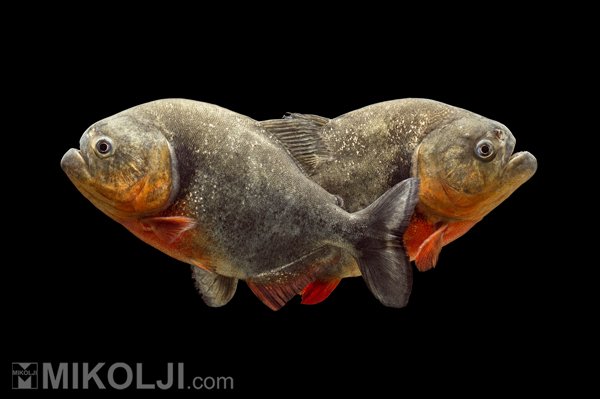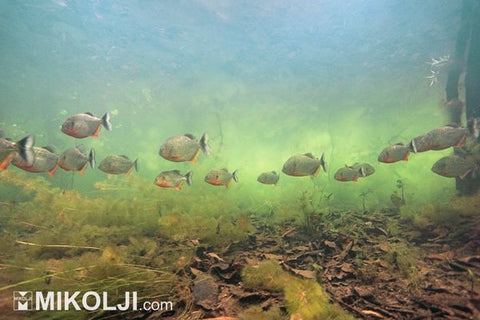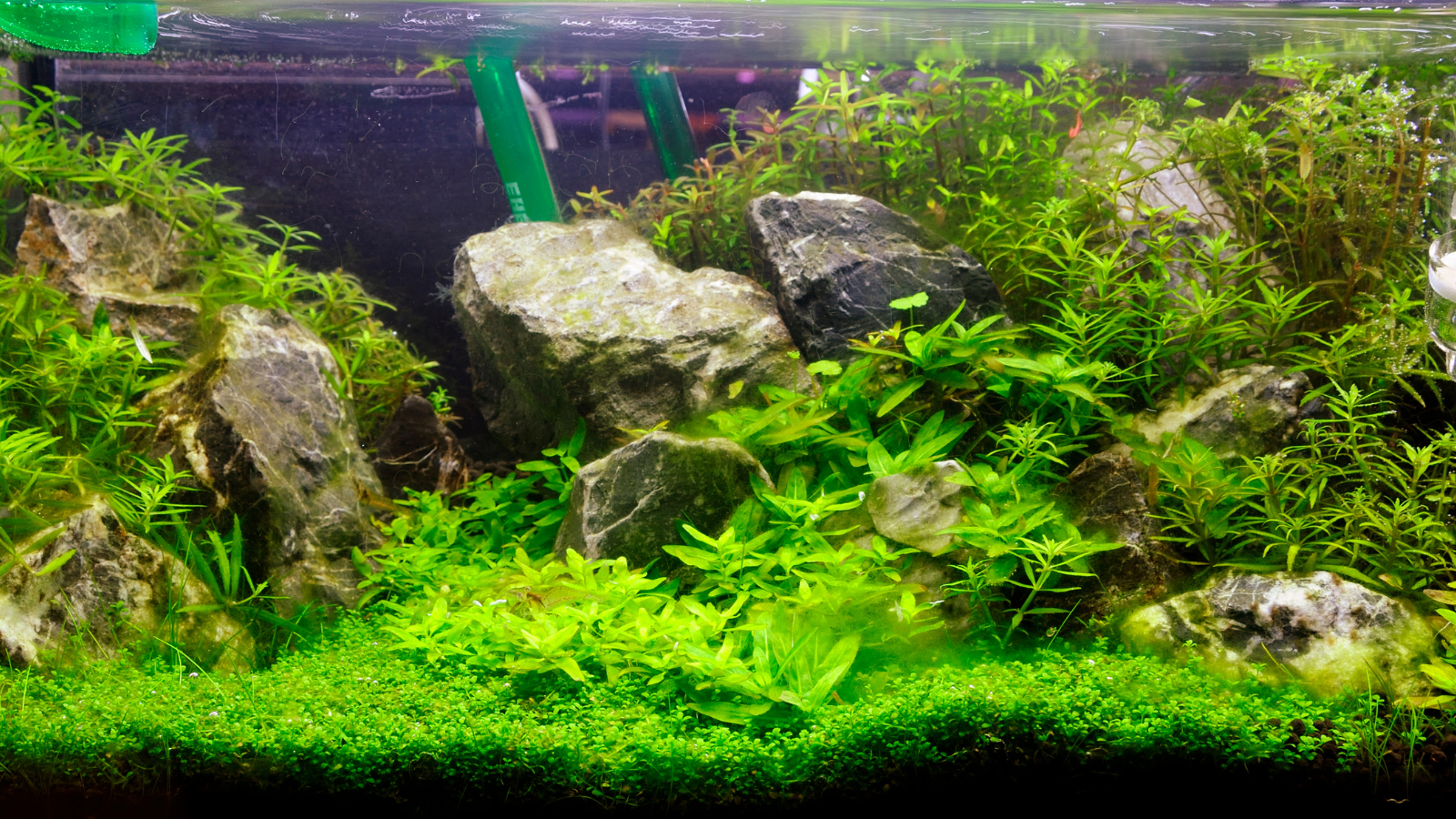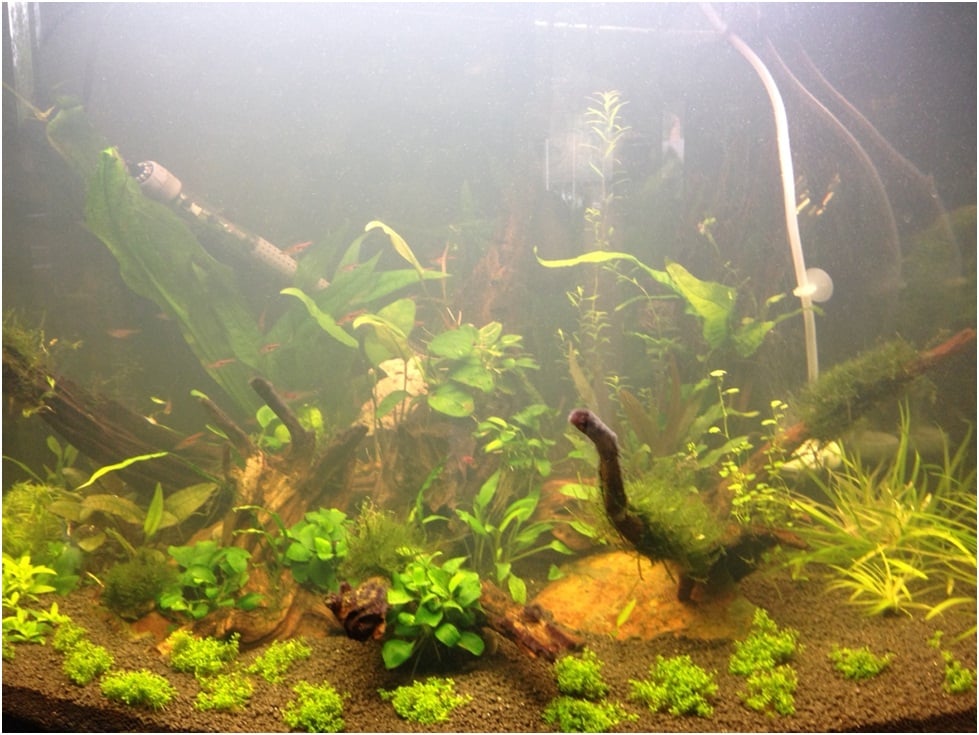
Piranha in the aquarium
Have any of you seen the movie "Piranhas" from the seventies? This old American movie inspired me to write the following article as many aquarists keep this species in their home tanks.
A brief description of the species
The Natterera Piranha (Red bellied Piranha, Pygocentrus nattereri) is a fairly common fish in the Amazon, Parana, Essequibo, Uruguay rivers, and in the rivers of the north-eastern coast of Brazil. It inhabits most of the habitats typical of its area, including main river channels, smaller tributaries, oxbow lakes, floodplain lakes, and artificial reservoirs created by dams. It is considered the most dangerous and aggressive fish in these waters. They can reach sizes of up to 33 cm and 3.85 kg. Usually, the lower body is dominated by a rusty orange coloration and the back is silver-gray. The dorsal and fatty fins are black. They live from 8-12 years.
How to set up a Piranha tank
Adult Piranhas require a very large aquarium. Although for a group of small individuals a 200-liter aquarium with a sandy substrate is sufficient. For adult Piranha in groups of 5-7 fish, a minimum tank capacity of 1000 liters and a length of at least 200 cm is recommended. In addition, they should be equipped with a cover so that they do not jump out, and all equipment should be secured against the razor sharp teeth. If the aquarium is suitably maintained, piranhas are active fish that will swim in the middle of the aquarium, if not, they look depressed and hide in the corners.
The substrate can be sand or fine gravel, because during the spawning period, in their natural habitat, piranhas will dig pits in which the female deposits her eggs. For this reason, it is recommended to choose solid and durable plants that can be attached to wood or rock above the substrate. Floating plants are also helpful due to their ability to consume excess nitrates that may be in the water. Floating plants are also intended to suppress the light reaching the water, as too intense exposure makes them skittish. Additionally, the aquarium should have a lot of hiding places in the form of roots or rocks. Remember that these fish naturally occur in the basins of the Amazon and other South American rivers, so the black water biotope is perfect here.
Water parameters
Red bellied Piranhas are fish with a very good metabolism, but they are very messy eaters, so contamination levels can be high. For this reason, a powerful external filter with frequent and large water changes are essential. PH should be between 6.5 and 7.8, alkalinity between 3 ° and 8 ° (50 ppm to 140 ppm), and temperature between 75 ° and 80 ° F.
The cast of the aquarium
When setting up an aquarium with piranhas, remember that these fish are prone to aggression. Juveniles usually are shoaling fish and tend to gather in groups to defend themselves against predators. However, when they grow up and if underfed, they can become cannibalistic. Therefore, having this species in your home tank, you need to feed it abundantly. Some experienced piranha breeders keep them in one tank, e.g. with larger fish species, large catfish, or even small neons, and although they may be in harmony for some time, they can be treated as a live food for larger tank mates at any time. For this reason, it is recommended to keep at least 5 piranhas.
Feeding
Red bellied Piranhas Piranhas are best fed with dead fish and other meaty foods. Although fairly common, the use of live feeder fish is not advised and aquarium trade leaders will all explain that ornamental fish used for this purpose (goldfish, guppies etc) carry parasites that could harm the Piranha. For this reason, only preprepared fresh or frozen meats are advised. Young Piranhas should be encouraged to take as many different kinds of food as possible to allow the fishkeeper to be able to offer a balanced diet of fresh freeze-dried foods along with dried appropriate pellet food. To tempt and encourage your Piranha to try new foods, the food can be moved (using tongs, not hands!) to replicate live animals and stimulate the hunting instincts of the fish. This applies to many Piranhas that are not yet used to the conditions in the aquarium.
Piranhas can be fed chicken or beef. However, this is not fully recommended as mammalian meat may contain fats that fish cannot digest. Over time, this can cause serious health problems. For the best Piranha care, a varied diet is recommended as well as food that they can eat within a few minutes. It is best to remove uneaten parts from the tank immediately to avoid affecting the water quality.
Breeding
Breeding most Piranha species at home is difficult, but not impossible. For this purpose, it is best to buy a group of about 6 piranhas, from which, with a bit of luck, a pair will form. During the mating season, the male digs holes in the substrate where the female lays about 300-400 transparent, yellowish eggs that hatch in 3-5 days. Then the larvae are best transferred to a separate container, e.g. using a sucker. After 7 days, the fry will be free swimming. At first, they are fed brine shrimp larvae, then chopped tubules and zooplankton. When the fish reach a length of 1.5-2 cm, they begin to attack each other. This can be avoided by separating them by size and feeding them well.
Safety rules
It is rare that fishkeepers receive a Piranha bite, it is advisable to follow increased security measures. Therefore, it is recommended to use wire gloves during any treatments in the aquarium. Usually, when cleaning an aquarium, piranhas swim away into a corner, but if they are insufficiently fed or consider our actions as a threat, they will likely attack. So, if you have to put your bare hands inside during tank maintenance, always be careful and ready to run away immediately. Don't underestimate their defensive behavior as they have razor-sharp teeth.
If you decide to breed piranhas in an aquarium, be aware that these fish are demanding. They need large amounts of varied food and frequent water changes. Also, remember that these fish live relatively long, and finding new homes for large fish is often not easy. Nevertheless, the red bellied piranha is undoubtedly a fascinating species that will impress anyone.
Images provided by Venezuelan river explorer Ivan Mikolji. For more visit: https://www.mikolji.com/redeye-piranha-artwork-catalogue/





